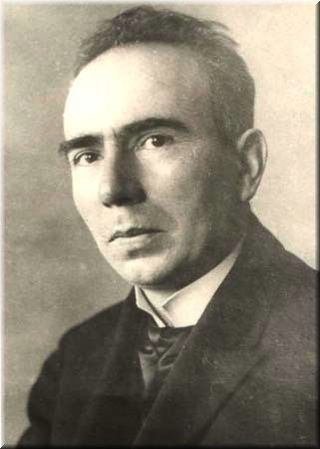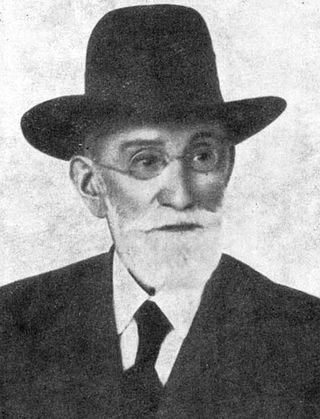
Aurel Vlaicu was a Romanian engineer, inventor, airplane constructor, and early pilot.
The World War I Victory Medal was a United States service medal designed by James Earle Fraser of New York City under the direction of the Commission of Fine Arts.

Vasile Pârvan was a Romanian historian and archaeologist.

The Victory Medal is a United Kingdom and British Empire First World War campaign medal.

The Order of the Star of Romania is Romania's highest civil Order and second highest State decoration after the Order of Michael the Brave. It is the oldest Order of Romania. It is awarded by the President of Romania, and has six grades, from lowest to the highest: Knight, Officer, Commander, Grand Officer, Grand Cross, and Grand Cross with Collar.
David Popescu was a Romanian general during World War II and Interior Minister in 1940.

The Order of the Crown of Romania is a chivalric order set up on 14 March 1881 by King Carol I of Romania to commemorate the establishment of the Kingdom of Romania. It was awarded as a state order until the end of the Romanian monarchy in 1947. It was revived on 30 December 2011 as a dynastic order.

The Order of Carol I was the highest ranking of the Romanian honours of the Kingdom of Romania until the founding of the Order of Michael the Brave in 1916 by King Ferdinand I of Romania. It was instituted on 10 May 1906 by King Carol I to celebrate the Ruby Jubilee of 40 years of his reign.
The Decorations of the Romanian Royal House are a reward for conspicuous and special merits of the recipients for the Romanian state and the Romanian Royal House.

The Inter-Allied Victory Medal is a campaign medal issued by Greece, commemorating the Allied victory in the First World War.

The 1914–1918 Inter-Allied Victory medal was a French commemorative medal established on 20 July 1922. It was the French version of a common allied campaign medal where each allied nation issued a Victory Medal to their own nationals, all issues having certain common features, including the same ribbon, a winged figure of victory on the obverse and a similar inscription on the reverse, the French version reading "LA GRANDE GVERRE POUR LA CIVILISATION 1914-1918".

The National Order of Merit is an order which is part of the National System of Decorations of Romania. A medal of merit also exists, but does not confer membership in the order.

The National Medal For Merit is a state decoration which is part of the National System of Decorations of Romania. It is the sixth highest honour awarded by Romania ranking just behind the Medal of Faithful Service and ahead of the Order of the Victory of the Romanian Revolution of December 1989.

The Victory Medal (South Africa) is the Union of South Africa's version of the Victory Medal (United Kingdom), a First World War campaign medal of Britain and her colonies and dominions. The medal, never awarded singly, was awarded to all those South Africans who were awarded the 1914–15 Star or the British War Medal.

Constantin C. Moisil was an Austro-Hungarian-born Romanian archivist, historian, numismatist and schoolteacher.

The Democratic Peasants' Party, also known as Democratic Party, Peasants' Party, National Democratic Party or Unirea Society, was a provincial party in Bukovina, Austria-Hungary, one of several groups claiming to represent the ethnic Romanians. It had a national liberal and left-wing populist agenda, and was mainly supported by "the peasants, the village teachers, and some of the intellectuals." Its leader was Aurel Onciul, seconded by Florea Lupu, both of whom were adversaries of the conservative and elitist Romanian National People's Party (PNPR). Rejecting sectarianism, the PȚD combined Austrian and Romanian nationalism, as Onciul argued that Romanian aspirations could only be fulfilled inside the multi-ethnic empire. For this reason, and for its role in dividing the Romanian vote, the party was often accused of double-dealing.

The Commemorative Cross of the 1916–1918 War is a Romanian First World War campaign medal established on 8 July 1918 by Royal Decree. The Decree was amended four times, in 1919, 1920, 1927 and 1939.

Alexandru Barbu Știrbei, also rendered Alex. Știrbeĭ, Știrbey, or Știrbeiŭ, was a Wallachian-born Romanian aristocrat, politician, businessman and agriculturalist, the son of Barbu Dimitrie Știrbei, Prince of Wallachia, younger brother of George Barbu Știrbei, and nephew of another Prince, Gheorghe Bibescu. After a short career in the French Army, he returned to the United Principalities and served terms in their Assembly of Deputies, inheriting the fortune left by his father. He established pioneering industries around his manorial estates of Buftea and Dărmănești, and became a guest, and sometime host, of literary meetings held by the political club Junimea.
Leca or Lecca of Cătun, also known as Leca of Leurdeni, Leca Rudeanu, Comisul Leca, or Postelnico Leka, was a Wallachian political figure, prominent under Princes Michael the Brave, Radu Șerban, and Radu Mihnea. Originally a Comis, his first major assignments came during Prince Michael's conquest of Transylvania, when he also submitted to, and fought for, the Holy Roman Empire. Leca was a commander of Wallachian troops in Michael's battles at Mirăslău (1600) and Guruslău (1601), returning to Wallachia after Michael's assassination.
Events from the year 1921 in Romania. The year saw the formation of the Romanian Communist Party out of the Socialist Party and subsequent imprisonment of the Communist leadership.













































